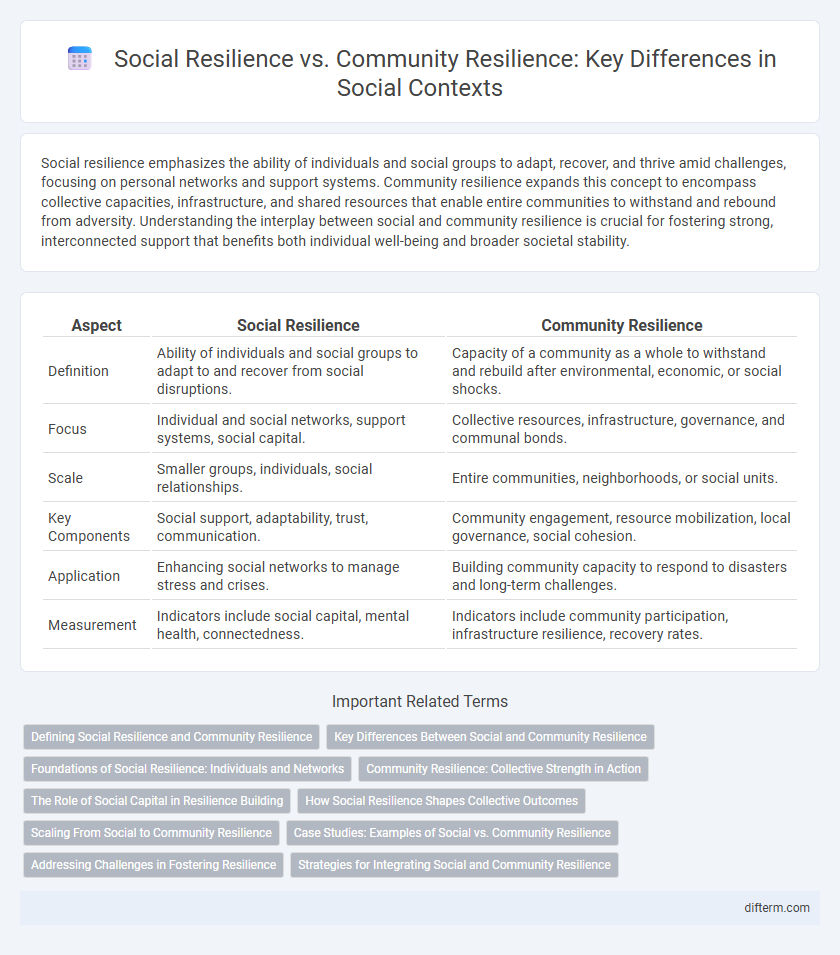Social resilience emphasizes the ability of individuals and social groups to adapt, recover, and thrive amid challenges, focusing on personal networks and support systems. Community resilience expands this concept to encompass collective capacities, infrastructure, and shared resources that enable entire communities to withstand and rebound from adversity. Understanding the interplay between social and community resilience is crucial for fostering strong, interconnected support that benefits both individual well-being and broader societal stability.
Table of Comparison
| Aspect | Social Resilience | Community Resilience |
|---|---|---|
| Definition | Ability of individuals and social groups to adapt to and recover from social disruptions. | Capacity of a community as a whole to withstand and rebuild after environmental, economic, or social shocks. |
| Focus | Individual and social networks, support systems, social capital. | Collective resources, infrastructure, governance, and communal bonds. |
| Scale | Smaller groups, individuals, social relationships. | Entire communities, neighborhoods, or social units. |
| Key Components | Social support, adaptability, trust, communication. | Community engagement, resource mobilization, local governance, social cohesion. |
| Application | Enhancing social networks to manage stress and crises. | Building community capacity to respond to disasters and long-term challenges. |
| Measurement | Indicators include social capital, mental health, connectedness. | Indicators include community participation, infrastructure resilience, recovery rates. |
Defining Social Resilience and Community Resilience
Social resilience refers to the capacity of individuals and groups to withstand and adapt to external stresses and shocks such as economic downturns, natural disasters, or social conflicts. Community resilience encompasses the collective ability of a community to anticipate, prepare for, respond to, and recover from adverse situations by leveraging local resources, social networks, and shared institutions. Both concepts emphasize adaptability, but social resilience focuses more on individual and interpersonal dynamics, while community resilience highlights the strength and cohesion of the community as a whole.
Key Differences Between Social and Community Resilience
Social resilience refers to the ability of individuals and larger social groups to withstand and adapt to stressors such as economic shocks or social upheaval, emphasizing broader societal networks and institutions. Community resilience focuses on localized collective capacity, highlighting the strength of social ties, local resources, and shared identities that enable neighborhoods or specific groups to recover from disturbances. Key differences include scale, with social resilience operating at a macro level across multiple communities, while community resilience is concerned with micro-level interactions and resource mobilization within a particular population.
Foundations of Social Resilience: Individuals and Networks
Foundations of social resilience center on the ability of individuals and their networks to absorb, adapt, and recover from social disruptions. Strong interpersonal relationships and community ties enhance collective capacity by fostering trust, resource sharing, and emotional support. These interconnected social structures create adaptive systems that reinforce both individual well-being and community resilience in times of crisis.
Community Resilience: Collective Strength in Action
Community resilience embodies the collective strength of individuals and organizations working together to respond, adapt, and thrive amid social challenges. It leverages local networks, shared resources, and inclusive participation to build capacity against economic, environmental, and social disruptions. This dynamic synergy fosters sustainable recovery and long-term well-being, reinforcing the community's ability to withstand future adversities.
The Role of Social Capital in Resilience Building
Social capital, encompassing trust, networks, and norms, is pivotal in both social and community resilience by facilitating cooperation and resource sharing during crises. High levels of social capital enhance adaptive capacity, enabling communities and individuals to recover more rapidly from shocks. Strengthening social capital through inclusive participation and strong interpersonal relationships directly contributes to resilient social systems and cohesive community structures.
How Social Resilience Shapes Collective Outcomes
Social resilience strengthens a community's ability to adapt to social stressors such as economic hardship or social conflict, directly influencing collective well-being and recovery. This dynamic capacity fosters trust, social networks, and resource sharing, which are essential for coordinated action and effective problem-solving. Enhanced social resilience results in more robust collective outcomes by promoting inclusivity, reducing vulnerability, and enabling communities to navigate and thrive amid disruptions.
Scaling From Social to Community Resilience
Social resilience refers to the capacity of individuals and small groups to withstand and adapt to social challenges, while community resilience encompasses the collective ability of entire communities to recover from disruptions. Scaling from social to community resilience involves leveraging individual social networks, shared values, and collaborative resources to strengthen broader community systems. Effective integration of social capital and institutional support facilitates adaptive strategies that enhance overall community resilience against environmental, economic, and social stresses.
Case Studies: Examples of Social vs. Community Resilience
Case studies reveal that social resilience often emphasizes individual and network capacity to adapt to stress, such as the mental health support networks during the 2011 Christchurch earthquake. Community resilience examples highlight collective action and shared resources, demonstrated by the grassroots rebuilding efforts after Hurricane Katrina in New Orleans. Comparing these cases underscores how social resilience supports personal recovery, while community resilience fosters long-term, systemic recovery through group solidarity.
Addressing Challenges in Fostering Resilience
Social resilience emphasizes individuals' and groups' capacity to recover from stress and adversity, while community resilience focuses on collective resources and networks that support recovery. Addressing challenges in fostering resilience requires enhancing adaptive capacities through inclusive participation, social cohesion, and equitable resource distribution. Building robust communication channels and trust within communities facilitates effective collaboration and mobilization during crises.
Strategies for Integrating Social and Community Resilience
Strategies for integrating social and community resilience emphasize collaborative networks that strengthen social capital and foster collective action during crises. Emphasizing inclusive communication channels and shared resource management enhances adaptive capacity and promotes equitable recovery outcomes. Leveraging local knowledge alongside institutional support ensures comprehensive resilience that addresses both individual well-being and community sustainability.
social resilience vs community resilience Infographic

 difterm.com
difterm.com